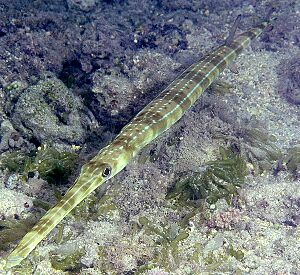Cornetfish facts for kids
Cornetfishes, also known as flutemouths, are a small group of very long, thin fish. They belong to a family called Fistulariidae. There is only one main group, or genus, called Fistularia, which has four different kinds of cornetfish. You can find them all over the world in warm ocean waters.
Quick facts for kids Cornetfish |
|
|---|---|
 |
|
| Fistularia commersonii | |
| Scientific classification |
|
| Kingdom: | Animalia |
| Phylum: | Chordata |
| Class: | Actinopterygii |
| Order: | Syngnathiformes |
| Suborder: | Aulostomoidei |
| Superfamily: | Aulostomoidea |
| Family: | Fistulariidae Blainville, 1818 |
| Genus: | Fistularia Linnaeus, 1758 |
| Type species | |
| Fistularia tabacaria Linnaeus, 1758
|
|
| Species | |
|
See text. |
|
| Synonyms | |
|
|
These fish can grow up to 2 meters (about 6.5 feet) long! They are as thin and long as many eels. However, cornetfishes have some special features. They have very long snouts, clear dorsal (top) and anal fins (bottom), and a forked tail fin. The middle rays of their tail fin form a long, thin string. Their lateral line (a sensory organ) is easy to see and goes all the way to this tail string.
Contents
Where Cornetfish Live
Cornetfish live in tropical and warm ocean waters around the world. You can find them in the Atlantic, Pacific, and Indian Oceans. They often live in coastal areas where the ocean floor is soft. This includes places like coral reefs, sandy areas, and beds of seagrass.
What Cornetfish Eat
Cornetfish are hunters! They like to eat small fish, crustaceans (like shrimp and crabs), and other small sea animals without backbones. They use their long snouts to help them catch their food.
Cornetfish and People
People sometimes catch cornetfish for food. They are not a major fish for fishing, but you might find them in local markets in the areas where they live.
Types of Cornetfish
There are four main types of cornetfish that scientists know about:
- Fistularia commersonii (also called blue-spotted or smooth cornetfish)
- Fistularia corneta (known as the Pacific cornetfish)
- Fistularia petimba (the red cornetfish)
- Fistularia tabacaria (another type of cornetfish or blue-spotted cornetfish)
See also
 In Spanish: Peces corneta para niños
In Spanish: Peces corneta para niños

